TLAW 202 Corporations Law: Incorporation, Separate Legal Entity Limits
VerifiedAdded on 2023/06/11
|8
|2429
|272
Report
AI Summary
This report addresses two key issues in Australian Corporations Law. The first question analyzes the process of company registration and name selection, referencing the Corporations Act 2001 and relevant case law. It discusses the steps involved in registering a company, including selecting the company type, finalizing the name, and complying with ASIC regulations, applying these principles to a scenario involving Richard, David, and Liam. The second question concerns the separate legal entity doctrine and its limitations, particularly in cases involving subsidiary companies and potential liability for injuries. It examines the circumstances under which the corporate veil can be pierced, holding parent companies accountable for the actions of their subsidiaries, with reference to cases like Salomon v A Salomon and Co Ltd and CSR Ltd v Wren, and applies these principles to a scenario involving Terry and Cosmo Mining Services Pty Ltd. The report concludes by suggesting potential avenues of action for Terry, considering the relationships between Lazarus Pty Ltd, Cosmo Mining Services Pty Ltd, and Cosmo Mine Ltd.
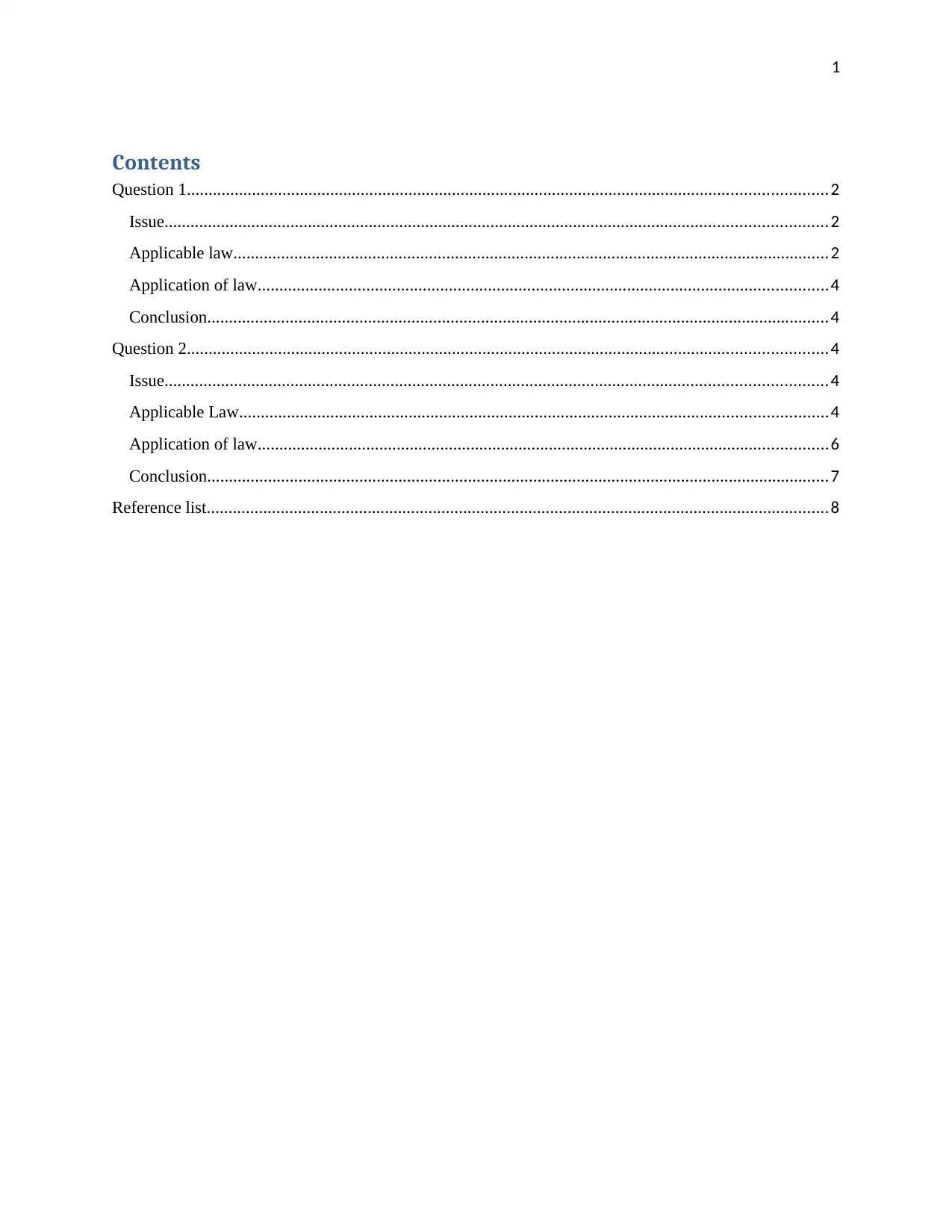
1
Contents
Question 1...................................................................................................................................................2
Issue........................................................................................................................................................2
Applicable law.........................................................................................................................................2
Application of law...................................................................................................................................4
Conclusion...............................................................................................................................................4
Question 2...................................................................................................................................................4
Issue........................................................................................................................................................4
Applicable Law.......................................................................................................................................4
Application of law...................................................................................................................................6
Conclusion...............................................................................................................................................7
Reference list...............................................................................................................................................8
Contents
Question 1...................................................................................................................................................2
Issue........................................................................................................................................................2
Applicable law.........................................................................................................................................2
Application of law...................................................................................................................................4
Conclusion...............................................................................................................................................4
Question 2...................................................................................................................................................4
Issue........................................................................................................................................................4
Applicable Law.......................................................................................................................................4
Application of law...................................................................................................................................6
Conclusion...............................................................................................................................................7
Reference list...............................................................................................................................................8
Paraphrase This Document
Need a fresh take? Get an instant paraphrase of this document with our AI Paraphraser
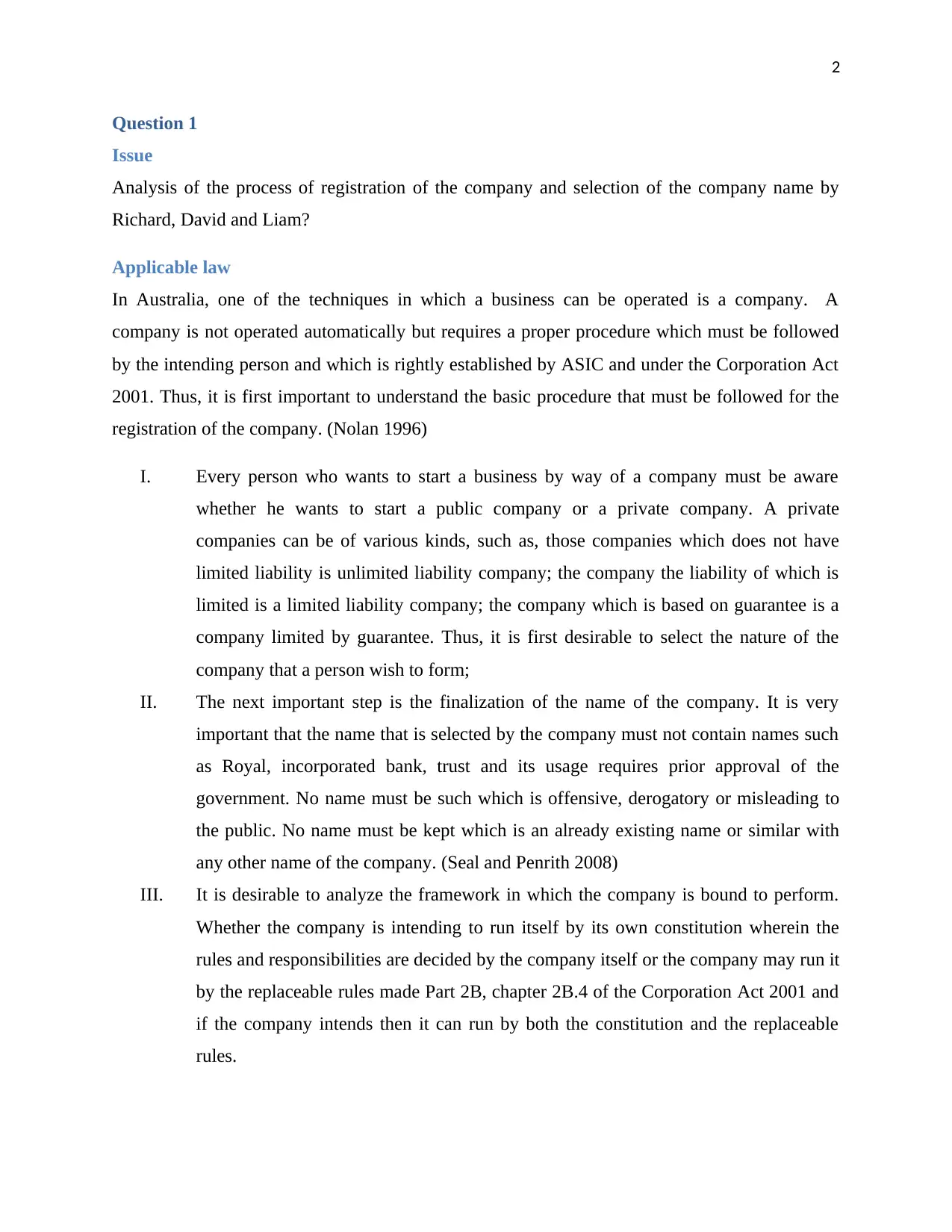
2
Question 1
Issue
Analysis of the process of registration of the company and selection of the company name by
Richard, David and Liam?
Applicable law
In Australia, one of the techniques in which a business can be operated is a company. A
company is not operated automatically but requires a proper procedure which must be followed
by the intending person and which is rightly established by ASIC and under the Corporation Act
2001. Thus, it is first important to understand the basic procedure that must be followed for the
registration of the company. (Nolan 1996)
I. Every person who wants to start a business by way of a company must be aware
whether he wants to start a public company or a private company. A private
companies can be of various kinds, such as, those companies which does not have
limited liability is unlimited liability company; the company the liability of which is
limited is a limited liability company; the company which is based on guarantee is a
company limited by guarantee. Thus, it is first desirable to select the nature of the
company that a person wish to form;
II. The next important step is the finalization of the name of the company. It is very
important that the name that is selected by the company must not contain names such
as Royal, incorporated bank, trust and its usage requires prior approval of the
government. No name must be such which is offensive, derogatory or misleading to
the public. No name must be kept which is an already existing name or similar with
any other name of the company. (Seal and Penrith 2008)
III. It is desirable to analyze the framework in which the company is bound to perform.
Whether the company is intending to run itself by its own constitution wherein the
rules and responsibilities are decided by the company itself or the company may run it
by the replaceable rules made Part 2B, chapter 2B.4 of the Corporation Act 2001 and
if the company intends then it can run by both the constitution and the replaceable
rules.
Question 1
Issue
Analysis of the process of registration of the company and selection of the company name by
Richard, David and Liam?
Applicable law
In Australia, one of the techniques in which a business can be operated is a company. A
company is not operated automatically but requires a proper procedure which must be followed
by the intending person and which is rightly established by ASIC and under the Corporation Act
2001. Thus, it is first important to understand the basic procedure that must be followed for the
registration of the company. (Nolan 1996)
I. Every person who wants to start a business by way of a company must be aware
whether he wants to start a public company or a private company. A private
companies can be of various kinds, such as, those companies which does not have
limited liability is unlimited liability company; the company the liability of which is
limited is a limited liability company; the company which is based on guarantee is a
company limited by guarantee. Thus, it is first desirable to select the nature of the
company that a person wish to form;
II. The next important step is the finalization of the name of the company. It is very
important that the name that is selected by the company must not contain names such
as Royal, incorporated bank, trust and its usage requires prior approval of the
government. No name must be such which is offensive, derogatory or misleading to
the public. No name must be kept which is an already existing name or similar with
any other name of the company. (Seal and Penrith 2008)
III. It is desirable to analyze the framework in which the company is bound to perform.
Whether the company is intending to run itself by its own constitution wherein the
rules and responsibilities are decided by the company itself or the company may run it
by the replaceable rules made Part 2B, chapter 2B.4 of the Corporation Act 2001 and
if the company intends then it can run by both the constitution and the replaceable
rules.
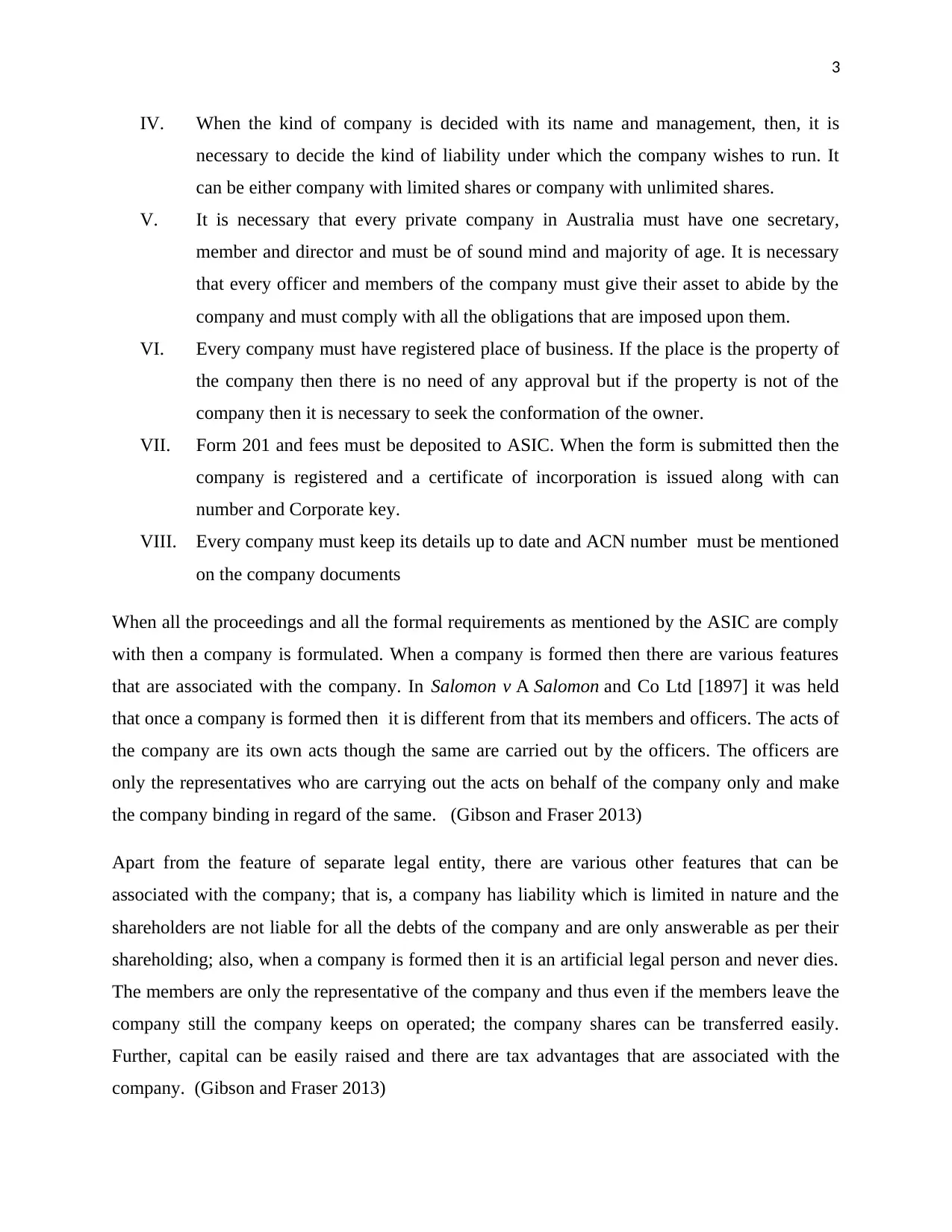
3
IV. When the kind of company is decided with its name and management, then, it is
necessary to decide the kind of liability under which the company wishes to run. It
can be either company with limited shares or company with unlimited shares.
V. It is necessary that every private company in Australia must have one secretary,
member and director and must be of sound mind and majority of age. It is necessary
that every officer and members of the company must give their asset to abide by the
company and must comply with all the obligations that are imposed upon them.
VI. Every company must have registered place of business. If the place is the property of
the company then there is no need of any approval but if the property is not of the
company then it is necessary to seek the conformation of the owner.
VII. Form 201 and fees must be deposited to ASIC. When the form is submitted then the
company is registered and a certificate of incorporation is issued along with can
number and Corporate key.
VIII. Every company must keep its details up to date and ACN number must be mentioned
on the company documents
When all the proceedings and all the formal requirements as mentioned by the ASIC are comply
with then a company is formulated. When a company is formed then there are various features
that are associated with the company. In Salomon v A Salomon and Co Ltd [1897] it was held
that once a company is formed then it is different from that its members and officers. The acts of
the company are its own acts though the same are carried out by the officers. The officers are
only the representatives who are carrying out the acts on behalf of the company only and make
the company binding in regard of the same. (Gibson and Fraser 2013)
Apart from the feature of separate legal entity, there are various other features that can be
associated with the company; that is, a company has liability which is limited in nature and the
shareholders are not liable for all the debts of the company and are only answerable as per their
shareholding; also, when a company is formed then it is an artificial legal person and never dies.
The members are only the representative of the company and thus even if the members leave the
company still the company keeps on operated; the company shares can be transferred easily.
Further, capital can be easily raised and there are tax advantages that are associated with the
company. (Gibson and Fraser 2013)
IV. When the kind of company is decided with its name and management, then, it is
necessary to decide the kind of liability under which the company wishes to run. It
can be either company with limited shares or company with unlimited shares.
V. It is necessary that every private company in Australia must have one secretary,
member and director and must be of sound mind and majority of age. It is necessary
that every officer and members of the company must give their asset to abide by the
company and must comply with all the obligations that are imposed upon them.
VI. Every company must have registered place of business. If the place is the property of
the company then there is no need of any approval but if the property is not of the
company then it is necessary to seek the conformation of the owner.
VII. Form 201 and fees must be deposited to ASIC. When the form is submitted then the
company is registered and a certificate of incorporation is issued along with can
number and Corporate key.
VIII. Every company must keep its details up to date and ACN number must be mentioned
on the company documents
When all the proceedings and all the formal requirements as mentioned by the ASIC are comply
with then a company is formulated. When a company is formed then there are various features
that are associated with the company. In Salomon v A Salomon and Co Ltd [1897] it was held
that once a company is formed then it is different from that its members and officers. The acts of
the company are its own acts though the same are carried out by the officers. The officers are
only the representatives who are carrying out the acts on behalf of the company only and make
the company binding in regard of the same. (Gibson and Fraser 2013)
Apart from the feature of separate legal entity, there are various other features that can be
associated with the company; that is, a company has liability which is limited in nature and the
shareholders are not liable for all the debts of the company and are only answerable as per their
shareholding; also, when a company is formed then it is an artificial legal person and never dies.
The members are only the representative of the company and thus even if the members leave the
company still the company keeps on operated; the company shares can be transferred easily.
Further, capital can be easily raised and there are tax advantages that are associated with the
company. (Gibson and Fraser 2013)
⊘ This is a preview!⊘
Do you want full access?
Subscribe today to unlock all pages.

Trusted by 1+ million students worldwide

4
The law related to company registration and requirements of name for company is now applied.
Application of law
In the Hunter valley region of NSW, Richard has an extensive olive grove with 12,000 trees and
is expanding. David and Liam are the sons of Richard and had moved to Sydney to help Richard
in the expansion of the business. Thus, Richard, David and Liam must follow the process that is
valid down by ASIC in order to register their business in the form of a company and thus attain
the various distinct features of the company such as separate legal entity, tax benefits, limited
liability, perpetual succession, easy to raise capital etc.
Now, there are few name suggestions that are provided.
“Rich’s Guaranteed Olives”, is the name that is suggested by David and Liam in order to honor
their father. However, the name that is suggested gives an impression that rich quality of olives
are guaranteed by the company which is not true. Thus, a misconception is provided to the public
which will mislead them. Thus, the name that is suggested is not a right name.
However, Ridali is the name that is suggested by Richard. Richard intends the name as the same
is the combination of all of the three. Now, this name is not giving any kind of misleading
information to the public and should not be identical with any other name in order to be valid.
Conclusion
Thus a company can be registered with the name Ridali by comply with the process of
registration and attains the various features that of a company.
Question 2
Issue
Against whom Terry can take action for his injuries, Lazarus Pty Ltd, CMS and/or CM?
Applicable Law
In Salomon v A Salomon and Co Ltd [1897] it was held that once a company is formed then it is
different from that its members and officers. The acts of the company are its own acts though the
same are carried out by the officers of the company. The officers are only the representatives of
the company who are carrying out the acts on behalf of the company only and make the company
The law related to company registration and requirements of name for company is now applied.
Application of law
In the Hunter valley region of NSW, Richard has an extensive olive grove with 12,000 trees and
is expanding. David and Liam are the sons of Richard and had moved to Sydney to help Richard
in the expansion of the business. Thus, Richard, David and Liam must follow the process that is
valid down by ASIC in order to register their business in the form of a company and thus attain
the various distinct features of the company such as separate legal entity, tax benefits, limited
liability, perpetual succession, easy to raise capital etc.
Now, there are few name suggestions that are provided.
“Rich’s Guaranteed Olives”, is the name that is suggested by David and Liam in order to honor
their father. However, the name that is suggested gives an impression that rich quality of olives
are guaranteed by the company which is not true. Thus, a misconception is provided to the public
which will mislead them. Thus, the name that is suggested is not a right name.
However, Ridali is the name that is suggested by Richard. Richard intends the name as the same
is the combination of all of the three. Now, this name is not giving any kind of misleading
information to the public and should not be identical with any other name in order to be valid.
Conclusion
Thus a company can be registered with the name Ridali by comply with the process of
registration and attains the various features that of a company.
Question 2
Issue
Against whom Terry can take action for his injuries, Lazarus Pty Ltd, CMS and/or CM?
Applicable Law
In Salomon v A Salomon and Co Ltd [1897] it was held that once a company is formed then it is
different from that its members and officers. The acts of the company are its own acts though the
same are carried out by the officers of the company. The officers are only the representatives of
the company who are carrying out the acts on behalf of the company only and make the company
Paraphrase This Document
Need a fresh take? Get an instant paraphrase of this document with our AI Paraphraser
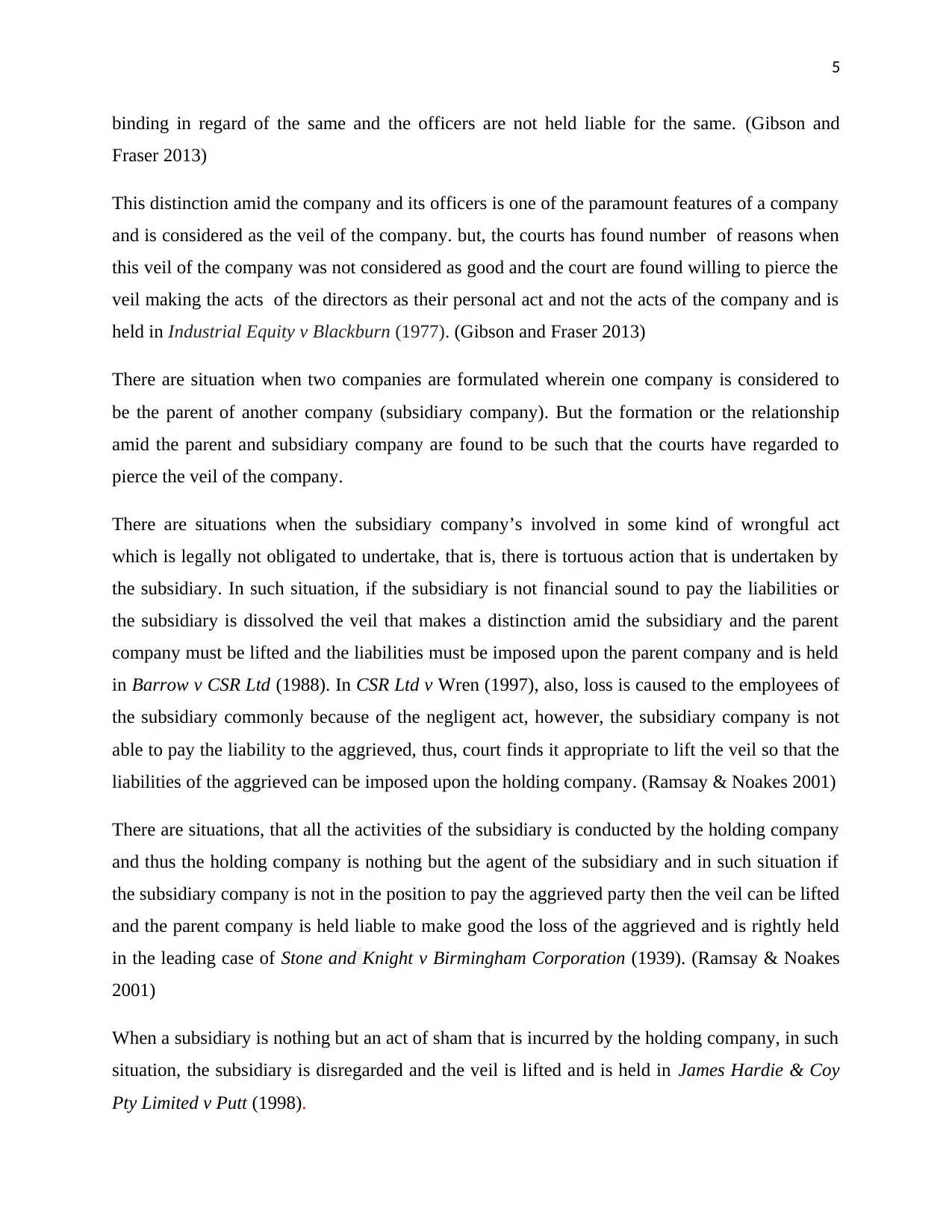
5
binding in regard of the same and the officers are not held liable for the same. (Gibson and
Fraser 2013)
This distinction amid the company and its officers is one of the paramount features of a company
and is considered as the veil of the company. but, the courts has found number of reasons when
this veil of the company was not considered as good and the court are found willing to pierce the
veil making the acts of the directors as their personal act and not the acts of the company and is
held in Industrial Equity v Blackburn (1977). (Gibson and Fraser 2013)
There are situation when two companies are formulated wherein one company is considered to
be the parent of another company (subsidiary company). But the formation or the relationship
amid the parent and subsidiary company are found to be such that the courts have regarded to
pierce the veil of the company.
There are situations when the subsidiary company’s involved in some kind of wrongful act
which is legally not obligated to undertake, that is, there is tortuous action that is undertaken by
the subsidiary. In such situation, if the subsidiary is not financial sound to pay the liabilities or
the subsidiary is dissolved the veil that makes a distinction amid the subsidiary and the parent
company must be lifted and the liabilities must be imposed upon the parent company and is held
in Barrow v CSR Ltd (1988). In CSR Ltd v Wren (1997), also, loss is caused to the employees of
the subsidiary commonly because of the negligent act, however, the subsidiary company is not
able to pay the liability to the aggrieved, thus, court finds it appropriate to lift the veil so that the
liabilities of the aggrieved can be imposed upon the holding company. (Ramsay & Noakes 2001)
There are situations, that all the activities of the subsidiary is conducted by the holding company
and thus the holding company is nothing but the agent of the subsidiary and in such situation if
the subsidiary company is not in the position to pay the aggrieved party then the veil can be lifted
and the parent company is held liable to make good the loss of the aggrieved and is rightly held
in the leading case of Stone and Knight v Birmingham Corporation (1939). (Ramsay & Noakes
2001)
When a subsidiary is nothing but an act of sham that is incurred by the holding company, in such
situation, the subsidiary is disregarded and the veil is lifted and is held in James Hardie & Coy
Pty Limited v Putt (1998).
binding in regard of the same and the officers are not held liable for the same. (Gibson and
Fraser 2013)
This distinction amid the company and its officers is one of the paramount features of a company
and is considered as the veil of the company. but, the courts has found number of reasons when
this veil of the company was not considered as good and the court are found willing to pierce the
veil making the acts of the directors as their personal act and not the acts of the company and is
held in Industrial Equity v Blackburn (1977). (Gibson and Fraser 2013)
There are situation when two companies are formulated wherein one company is considered to
be the parent of another company (subsidiary company). But the formation or the relationship
amid the parent and subsidiary company are found to be such that the courts have regarded to
pierce the veil of the company.
There are situations when the subsidiary company’s involved in some kind of wrongful act
which is legally not obligated to undertake, that is, there is tortuous action that is undertaken by
the subsidiary. In such situation, if the subsidiary is not financial sound to pay the liabilities or
the subsidiary is dissolved the veil that makes a distinction amid the subsidiary and the parent
company must be lifted and the liabilities must be imposed upon the parent company and is held
in Barrow v CSR Ltd (1988). In CSR Ltd v Wren (1997), also, loss is caused to the employees of
the subsidiary commonly because of the negligent act, however, the subsidiary company is not
able to pay the liability to the aggrieved, thus, court finds it appropriate to lift the veil so that the
liabilities of the aggrieved can be imposed upon the holding company. (Ramsay & Noakes 2001)
There are situations, that all the activities of the subsidiary is conducted by the holding company
and thus the holding company is nothing but the agent of the subsidiary and in such situation if
the subsidiary company is not in the position to pay the aggrieved party then the veil can be lifted
and the parent company is held liable to make good the loss of the aggrieved and is rightly held
in the leading case of Stone and Knight v Birmingham Corporation (1939). (Ramsay & Noakes
2001)
When a subsidiary is nothing but an act of sham that is incurred by the holding company, in such
situation, the subsidiary is disregarded and the veil is lifted and is held in James Hardie & Coy
Pty Limited v Putt (1998).

6
Now, any aggrieved employee is on the view that the company is not taking any action for the
losses that are caused to him because of the acts of the company, then, the employee has power
under section 236-237 of the Corporation Act 2001 to initiate application on his own behalf
provided it is in the interest of the company as a whole.
Application of law
Cosmo Mining Services Pty Ltd is the subsidiary of Cosmo Mine Ltd as out of 200 shares of
Cosmo Mining Services Pty Ltd, 120 shares are hold by Cosmo Mine Ltd. Terry is working with
Cosmo Mining Services Pty Ltd. Now, it is recently found out that Cosmo Mining Services Pty
Ltd is indulged in mining activities and which has contaminated the nearby river the water of
which is used at Gunbarrel. Now because of the use of the contaminated water, many Gunbarrel
employees including Terry have suffered with cancer.
It is now submitted that Cosmo Mining Services Pty Ltd in order to avoid its liability dissolved
the company and formulated a new company in the name of Lazarus Pty Ltd. the main aim of
forming Lazarus Pty Ltd is to avoid the liability of Cosmo Mining Services Pty Ltd. Thus, the
aim is to incur fraud on the employees of Cosmo Mining Services Pty Ltd including Terry. Thus,
the veil amid Cosmo Mining Services Pty Ltd and Lazarus Pty Ltd must be pierced and Cosmo
Mining Services Pty Ltd cannot shed away from its liabilities.
Further, Cosmo Mine Ltd is the holding company of Cosmo Mining Services Pty Ltd. the main
task of Cosmo Mine Ltd is that it leases all the mining related tools and then sub leases the same
to its subsidiary Cosmo Mining Services Pty Ltd. it is submitted that all the acts of Cosmo
Mining Services Pty Ltd is carried out by its holding company Cosmo Mine Ltd. There is a
presence of agency amid the two and it is required that the veil amid Cosmo Mine Ltd and
Cosmo Mining Services Pty Ltd must be pierced and the two companies must be treated as one.
The loss that is incurred by Terry and which must be recovered from Cosmo Mining Services Pty
Ltd must be imposed upon Cosmo Mine Ltd.
But, since no action is undertaken by Cosmo Mine Ltd or by Cosmo Mining Services Pty Ltd,
thus, by relying upon section 236-237 of the Corporation Act 2001, Terry can take action against
Cosmo Mine Ltd as the distinction amid Cosmo Mine Ltd and Cosmo Mining Services Pty Ltd is
now pierced.
Now, any aggrieved employee is on the view that the company is not taking any action for the
losses that are caused to him because of the acts of the company, then, the employee has power
under section 236-237 of the Corporation Act 2001 to initiate application on his own behalf
provided it is in the interest of the company as a whole.
Application of law
Cosmo Mining Services Pty Ltd is the subsidiary of Cosmo Mine Ltd as out of 200 shares of
Cosmo Mining Services Pty Ltd, 120 shares are hold by Cosmo Mine Ltd. Terry is working with
Cosmo Mining Services Pty Ltd. Now, it is recently found out that Cosmo Mining Services Pty
Ltd is indulged in mining activities and which has contaminated the nearby river the water of
which is used at Gunbarrel. Now because of the use of the contaminated water, many Gunbarrel
employees including Terry have suffered with cancer.
It is now submitted that Cosmo Mining Services Pty Ltd in order to avoid its liability dissolved
the company and formulated a new company in the name of Lazarus Pty Ltd. the main aim of
forming Lazarus Pty Ltd is to avoid the liability of Cosmo Mining Services Pty Ltd. Thus, the
aim is to incur fraud on the employees of Cosmo Mining Services Pty Ltd including Terry. Thus,
the veil amid Cosmo Mining Services Pty Ltd and Lazarus Pty Ltd must be pierced and Cosmo
Mining Services Pty Ltd cannot shed away from its liabilities.
Further, Cosmo Mine Ltd is the holding company of Cosmo Mining Services Pty Ltd. the main
task of Cosmo Mine Ltd is that it leases all the mining related tools and then sub leases the same
to its subsidiary Cosmo Mining Services Pty Ltd. it is submitted that all the acts of Cosmo
Mining Services Pty Ltd is carried out by its holding company Cosmo Mine Ltd. There is a
presence of agency amid the two and it is required that the veil amid Cosmo Mine Ltd and
Cosmo Mining Services Pty Ltd must be pierced and the two companies must be treated as one.
The loss that is incurred by Terry and which must be recovered from Cosmo Mining Services Pty
Ltd must be imposed upon Cosmo Mine Ltd.
But, since no action is undertaken by Cosmo Mine Ltd or by Cosmo Mining Services Pty Ltd,
thus, by relying upon section 236-237 of the Corporation Act 2001, Terry can take action against
Cosmo Mine Ltd as the distinction amid Cosmo Mine Ltd and Cosmo Mining Services Pty Ltd is
now pierced.
⊘ This is a preview!⊘
Do you want full access?
Subscribe today to unlock all pages.

Trusted by 1+ million students worldwide

7
Conclusion
The veil amid Cosmo Mining Services Pty Ltd and Cosmo Mine Ltd are now removed and Terry
by availing his rights under section 236-237 of the Corporation Act 2001 can sue Cosmo Mine
Ltd.
Conclusion
The veil amid Cosmo Mining Services Pty Ltd and Cosmo Mine Ltd are now removed and Terry
by availing his rights under section 236-237 of the Corporation Act 2001 can sue Cosmo Mine
Ltd.
Paraphrase This Document
Need a fresh take? Get an instant paraphrase of this document with our AI Paraphraser
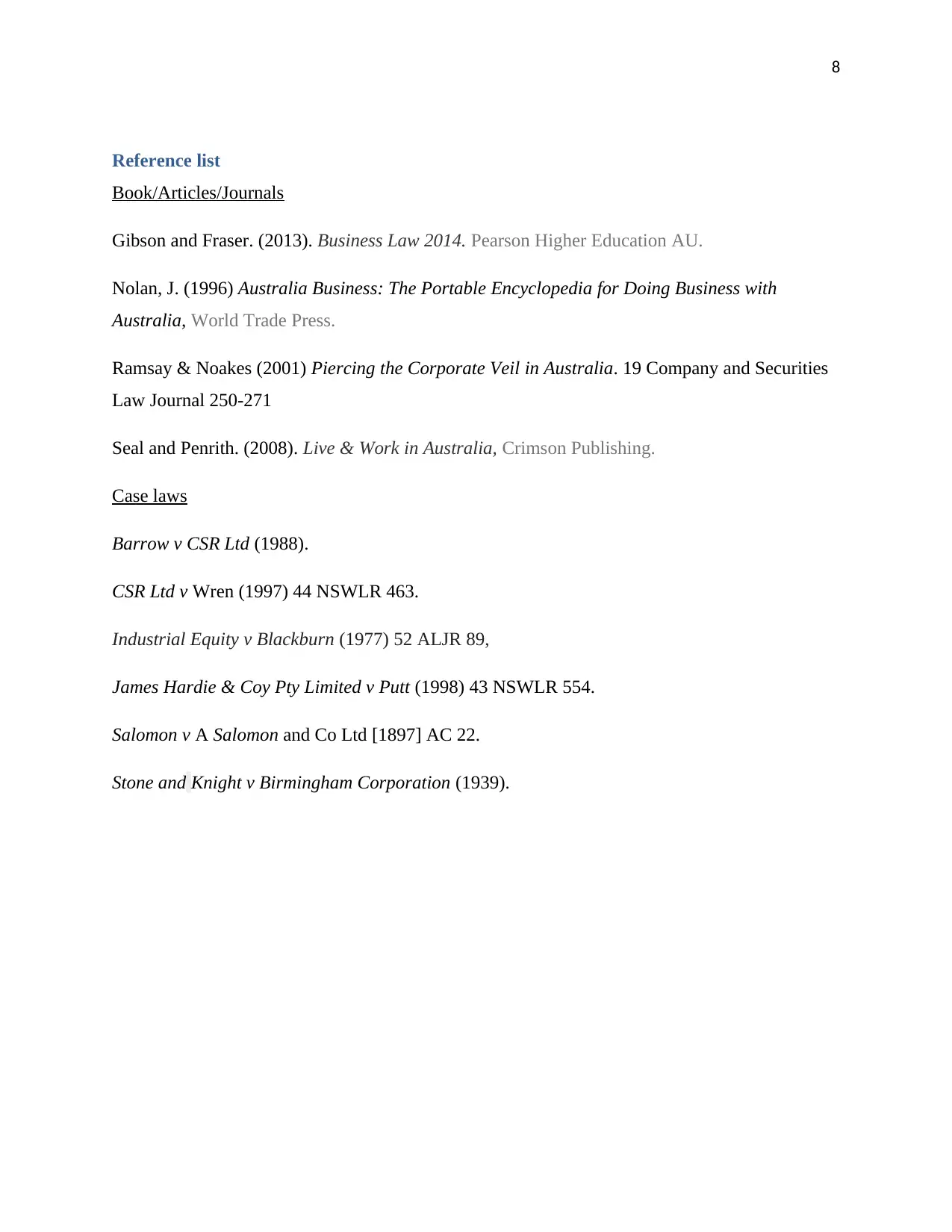
8
Reference list
Book/Articles/Journals
Gibson and Fraser. (2013). Business Law 2014. Pearson Higher Education AU.
Nolan, J. (1996) Australia Business: The Portable Encyclopedia for Doing Business with
Australia, World Trade Press.
Ramsay & Noakes (2001) Piercing the Corporate Veil in Australia. 19 Company and Securities
Law Journal 250-271
Seal and Penrith. (2008). Live & Work in Australia, Crimson Publishing.
Case laws
Barrow v CSR Ltd (1988).
CSR Ltd v Wren (1997) 44 NSWLR 463.
Industrial Equity v Blackburn (1977) 52 ALJR 89,
James Hardie & Coy Pty Limited v Putt (1998) 43 NSWLR 554.
Salomon v A Salomon and Co Ltd [1897] AC 22.
Stone and Knight v Birmingham Corporation (1939).
Reference list
Book/Articles/Journals
Gibson and Fraser. (2013). Business Law 2014. Pearson Higher Education AU.
Nolan, J. (1996) Australia Business: The Portable Encyclopedia for Doing Business with
Australia, World Trade Press.
Ramsay & Noakes (2001) Piercing the Corporate Veil in Australia. 19 Company and Securities
Law Journal 250-271
Seal and Penrith. (2008). Live & Work in Australia, Crimson Publishing.
Case laws
Barrow v CSR Ltd (1988).
CSR Ltd v Wren (1997) 44 NSWLR 463.
Industrial Equity v Blackburn (1977) 52 ALJR 89,
James Hardie & Coy Pty Limited v Putt (1998) 43 NSWLR 554.
Salomon v A Salomon and Co Ltd [1897] AC 22.
Stone and Knight v Birmingham Corporation (1939).
1 out of 8
Related Documents
Your All-in-One AI-Powered Toolkit for Academic Success.
+13062052269
info@desklib.com
Available 24*7 on WhatsApp / Email
![[object Object]](/_next/static/media/star-bottom.7253800d.svg)
Unlock your academic potential
Copyright © 2020–2025 A2Z Services. All Rights Reserved. Developed and managed by ZUCOL.




